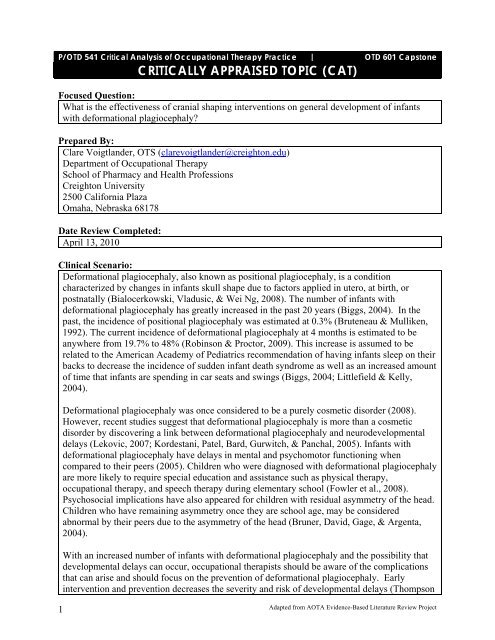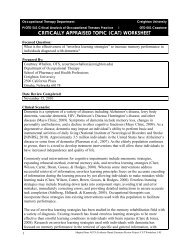CRITICALLY APPRAISED TOPIC (CAT) - Creighton University
CRITICALLY APPRAISED TOPIC (CAT) - Creighton University
CRITICALLY APPRAISED TOPIC (CAT) - Creighton University
You also want an ePaper? Increase the reach of your titles
YUMPU automatically turns print PDFs into web optimized ePapers that Google loves.
P/OTD 541 Critical Analysis of Occupational Therapy Practice | OTD 601 Capstone<br />
<strong>CRITICALLY</strong> <strong>APPRAISED</strong> <strong>TOPIC</strong> (<strong>CAT</strong>)<br />
Focused Question:<br />
What is the effectiveness of cranial shaping interventions on general development of infants<br />
with deformational plagiocephaly?<br />
Prepared By:<br />
Clare Voigtlander, OTS (clarevoigtlander@creighton.edu)<br />
Department of Occupational Therapy<br />
School of Pharmacy and Health Professions<br />
<strong>Creighton</strong> <strong>University</strong><br />
2500 California Plaza<br />
Omaha, Nebraska 68178<br />
Date Review Completed:<br />
April 13, 2010<br />
Clinical Scenario:<br />
Deformational plagiocephaly, also known as positional plagiocephaly, is a condition<br />
characterized by changes in infants skull shape due to factors applied in utero, at birth, or<br />
postnatally (Bialocerkowski, Vladusic, & Wei Ng, 2008). The number of infants with<br />
deformational plagiocephaly has greatly increased in the past 20 years (Biggs, 2004). In the<br />
past, the incidence of positional plagiocephaly was estimated at 0.3% (Bruteneau & Mulliken,<br />
1992). The current incidence of deformational plagiocephaly at 4 months is estimated to be<br />
anywhere from 19.7% to 48% (Robinson & Proctor, 2009). This increase is assumed to be<br />
related to the American Academy of Pediatrics recommendation of having infants sleep on their<br />
backs to decrease the incidence of sudden infant death syndrome as well as an increased amount<br />
of time that infants are spending in car seats and swings (Biggs, 2004; Littlefield & Kelly,<br />
2004).<br />
1<br />
Deformational plagiocephaly was once considered to be a purely cosmetic disorder (2008).<br />
However, recent studies suggest that deformational plagiocephaly is more than a cosmetic<br />
disorder by discovering a link between deformational plagiocephaly and neurodevelopmental<br />
delays (Lekovic, 2007; Kordestani, Patel, Bard, Gurwitch, & Panchal, 2005). Infants with<br />
deformational plagiocephaly have delays in mental and psychomotor functioning when<br />
compared to their peers (2005). Children who were diagnosed with deformational plagiocephaly<br />
are more likely to require special education and assistance such as physical therapy,<br />
occupational therapy, and speech therapy during elementary school (Fowler et al., 2008).<br />
Psychosocial implications have also appeared for children with residual asymmetry of the head.<br />
Children who have remaining asymmetry once they are school age, may be considered<br />
abnormal by their peers due to the asymmetry of the head (Bruner, David, Gage, & Argenta,<br />
2004).<br />
With an increased number of infants with deformational plagiocephaly and the possibility that<br />
developmental delays can occur, occupational therapists should be aware of the complications<br />
that can arise and should focus on the prevention of deformational plagiocephaly. Early<br />
intervention and prevention decreases the severity and risk of developmental delays (Thompson<br />
Adapted from AOTA Evidence-Based Literature Review Project
2<br />
et al., 2009). If prevention of deformational plagiocephaly is not successful, occupational<br />
therapists should be aware of the effectiveness of cranial shaping interventions and can educate<br />
parents on the importance of receiving interventions for their children, as well as, provide<br />
interventions. Treatment of deformational plagiocephaly includes the use of cranial orthotics,<br />
repositioning, and physical or occupational therapy (Bialocerkowski, Vladusic, & Howell,<br />
2005). Occupational therapists are able to provide comprehensive treatment for infants with<br />
deformational plagiocephaly.<br />
Summary of Key Findings:<br />
Summary of Levels I, II, and III<br />
• Cranial shaping using helmet therapy or repositioning with or without<br />
physiotherapy improves head shape in infants with deformational plagiocephaly<br />
(Bruner, David, Gage, & Argenta, 2004, Level III; Robinson & Proctor, 2009,<br />
Level I; Thompson et al, 2009, Level III)<br />
• There is a link between developmental delays or neurological injury with<br />
deformational plagiocephaly, casual relationship has not been identified<br />
(Leighton, 2008, Level I; Robinson & Proctor, 2009, Level I; )<br />
• School age children who have been diagnosed with deformational plagiocephaly<br />
showed developmental delays and required special education and therapy<br />
services more than non-affected peers, no difference was present between the<br />
groups treated with helmets and groups with repositioning (Leighton, 2008,<br />
Level I; Robinson & Proctor, 2009, Level I)<br />
• One study included in a systematic review reported no delay (Robinson &<br />
Proctor, 2009, Level I)<br />
• Repositioning and physiotherapy is effective for treating mild to moderate cases<br />
in infants under 6 months of age while cranial orthoses are effective for severe<br />
deformities, infants with mild to moderate deformities who are older than 6<br />
months, or do not respond to repositioning and physiotherapy (Robinson &<br />
Proctor, 2009, Level I; Xia et al., 2008, Level I)<br />
• Orthotic therapy does not seem to confer protection against developmental<br />
delays (Leighton, 2008, Level I)<br />
• Two studies found that helmet therapy is more effective than repositioning<br />
(Thompson et al, 2009, Level III; Xia et al., 2008, Level I). However the most<br />
effective conservative intervention cannot be established due to low order of<br />
study designs, inconsistent outcome measures, and inconsistent protocol of<br />
therapy as well as other biases and limitations (Leighton, 2008, Level I;<br />
Thompson et al, 2009, Level III)<br />
• Earlier intervention results in increased improvements (Thompson et al., 2009)<br />
• Higher compliance results in increased improvements (Burner, David, Gage, &<br />
Argenta, 2004, Level III; Thompson et al, 2009, Level III)<br />
Summary of Levels IV and V<br />
Level IV – None available for review<br />
Level V – None available for review<br />
Contributions of Qualitative Studies:<br />
Not included in review<br />
Adapted from AOTA Evidence-Based Literature Review Project
Bottom Line for Occupational Therapy Practice:<br />
There is evidence to support that cranial shaping interventions impact the general development<br />
of infants with plagiocephaly by improving head shape (Bruner, David, Gage, & Argenta, 2004;<br />
Robinson & Proctor, 2009; Thompson et al., 2009; Xia et al., 2008). As the incidence of<br />
deformational plagiocephaly increases, the need for the best practice to treat these infants rises.<br />
Results of this review indicate that repositioning is effective and should be used for infants with<br />
mild plagiocephaly and who are under 4 months of age. Helmet therapy is effective and should<br />
be used for infants over 4 months with moderate to severe plagiocephaly or infants who failed<br />
to respond to repositioning. (Robinson & Proctor, 2009; Xia et al., 2008). Since improvement<br />
was seen in head shape post intervention of infants with deformational plagiocephaly,<br />
occupational therapy practitioners should use cranial shaping interventions and should be<br />
reimbursed accordingly.<br />
3<br />
More rigorous research is needed to establish the cause of developmental delays in children<br />
with deformational plagiocephaly. Studies have identified that there is in fact a developmental<br />
delay present in infants who were diagnosed with deformational plagiocephaly, however it is<br />
unclear whether the delay caused the plagiocephaly or if the plagiocephaly resulted in<br />
developmental delays (Leighton, 2008). Although the cause of developmental delays is still<br />
unclear, occupational therapist should be not only focus on improving head shape, but should<br />
also focus on decreasing developmental delays. Therapists can promote development in infants<br />
with deformational plagiocephaly by educating parents on counterpositioning and increasing the<br />
amount of time spent in the prone position when awake. Therapists can also complete exercises<br />
to reduce positional preference and stimulate motor development (van Vlimmeren et al., 2008;<br />
Nuysink, J., 2009). Once the infants head shape has been corrected, parents should be advised<br />
to watch their children throughout school age for developmental delays (Bialockerkowski,<br />
Vladusic, & Wei Ng, 2008).<br />
Occupational therapists have the knowledge and skills to provide comprehensive treatment to<br />
infants with deformational plagiocephaly. Additional education and experience is needed for<br />
therapists to safely and effectively apply cranial molding devices to infants’ heads, since the<br />
orthosis applies pressure to certain areas of the infant’s skull. Occupational therapists have the<br />
knowledge to educate provide education to parents, to complete repositioning and exercises that<br />
do not involve applying pressure to the infants head without additional education.<br />
With the increase in the prevalence of deformational plagiocephaly in the past 20 years, there is<br />
an increase in societal need as well as a potential for program development. Occupational<br />
therapists will have an important role in the development of new helmet clinics as well as<br />
running the helmet clinics as the demand grows. Occupational therapists could also develop a<br />
program that could provide education to parents about the monitoring for plagiocephaly and the<br />
importance of repositioning to decrease the risk of plagiocephaly. Occupational therapists could<br />
also participate in additional research to determine the causative relationship between<br />
deformational plagiocephaly and developmental delays. Therapists should complete research to<br />
further support treatment protocols and screening processes in order to develop the most<br />
effective treatment plan for deformational plagiocephaly. The treatment of plagiocephaly<br />
should be reimbursed because a reduction in plagiocephaly and developmental delays can<br />
reduce hospitalization and rehabilitative costs.<br />
Adapted from AOTA Evidence-Based Literature Review Project
Review Process<br />
• Student identified focus question.<br />
• Key terms were developed.<br />
• Databases were searched using key terms.<br />
• Titles and abstracts of articles were retrieved.<br />
• Comprehensive literature search was completed.<br />
• Articles which appeared to be of high relevance were obtained for review.<br />
• Articles which met criteria were analyzed in the evidence table.<br />
Procedures for the selection and appraisal of articles<br />
Inclusion Criteria:<br />
• No limitations was used for the year articles were published, all relevant articles were<br />
included<br />
• Articles written in English<br />
• Peer review articles/journals<br />
• Research participants with plagiocephaly<br />
• Discussed impact of therapy on head shape or development of the child<br />
Exclusion Criteria:<br />
• Level V articles<br />
• Qualitative studies<br />
• Craniosynostosis<br />
• Surgical Interventions<br />
• Dissertations and Theses<br />
Search Strategy<br />
Categories Key Search Terms<br />
Patient/Client Population Infants, Newborns, Children, Babies, Deformational<br />
Plagiocephaly, Plagiocephaly, nonsynostotic, Flat Head<br />
Syndrome, Cranial Deformities<br />
Intervention Cranial Shaping, Helmet, Helmet Therapy, Molding Therapy,<br />
Cranial Molding, Cranial Osteopathy, Orthotic Devices,<br />
Repositioning, Physiotherapy<br />
Comparison Not searched<br />
Outcomes Developmental Delays, Cognitive Delays, Neurodevelopment,<br />
Delays, Crawl*, Walk*, Talk*, Cognit*, Language<br />
Developmental Disorder<br />
4<br />
Databases and Sites Searched<br />
MEDLINE, CINAHL, Humanities International Index, Communication & Mass Media Complete,<br />
Health Source-Consumer Edition, International Pharmaceutical Abstracts, Academic Search Premier,<br />
Business Source Premier, Regional Business News, EPIC, ATLA Religion Database with<br />
ATLASerials, MAS Ultra-School Edition, Military & Government Collection, Primary Search, Funk &<br />
Wagnalls New World Encylopedia, PsycINFO, MagillOnLiterature Plus, MLA International<br />
Bibliography, MLA Directory of Periodicals, SPORTDiscus, Dentistry & Oral Sciences Source,<br />
Google Scholar, ERIC, Web os Science, FirstSearch, EBSCOHost, OTsearch, SPORT, Chocrane<br />
Library, OT<strong>CAT</strong>S, Otseeker, JAMA Evidence<br />
Adapted from AOTA Evidence-Based Literature Review Project
Quality Control/Peer Review Process:<br />
• Occupational therapy student developed a focus question and search terms.<br />
• Instructor and teaching assistant reviewed the focus question and search terms.<br />
• Comprehensive literature search was completed by the student.<br />
• Instructor and teaching assistant completed a literature search to ensure that all articles<br />
had been included.<br />
• Instructor and teaching assistant reviewed level of evidence and priority of article to<br />
ensure that all articles had been located in the comprehensive literature search.<br />
• The student then completed the evidence table for all selected articles.<br />
• After the student completed the evidence table, the instructor and teaching assistant<br />
reviewed the table.<br />
• The critically appraised topic was then completed by the student and reviewed by the<br />
instructor and teaching assistant.<br />
Results of Search<br />
Summary of Study Designs of Articles Selected for Appraisal<br />
Level of Study Design/Methodology of Selected Articles Number of Articles<br />
Evidence<br />
Selected<br />
I Systematic reviews, meta-analysis, randomized<br />
controlled trials<br />
3<br />
II Two groups, nonrandomized studies (e.g., cohort,<br />
case-control)<br />
0<br />
III One group, nonrandomized (e.g., before and after,<br />
pretest, and posttest)<br />
2<br />
IV Descriptive studies that include analysis of outcomes<br />
(single subject design, case series)<br />
0<br />
V Case reports and expert opinion, which include<br />
narrative literature reviews and consensus statements<br />
0<br />
Qualitative Studies 0<br />
TOTAL 5<br />
Limitations of the Studies Appraised<br />
Levels I, II, and III<br />
Level I<br />
• Comparison of interventions is difficult due to available articles having low order of<br />
study designs, inconsistent outcome measures, inconsistent protocol of therapy<br />
(Leighton, 2008; Robinson & Proctor, 2009; Xia et al., 2008).<br />
5<br />
• Biases were present in many of the studies included in systematic reviews (Leighton,<br />
2008; Xia et al., 2008).<br />
• Systematic review was not comprehensive and missed a few articles ((Leighton,<br />
2008).<br />
• Higher level evidence and quality research is needed to determine the causative<br />
relationship between deformational plagiocephaly and developmental delay<br />
(Robinson & Proctor, 2009).<br />
Adapted from AOTA Evidence-Based Literature Review Project
6<br />
• Measurements without proven reliability and validity were used in the studies<br />
included (Robinson & Proctor, 2009). This also contributes to the difficulty in<br />
comparing interventions.<br />
• Studies were difficult to assess due to flaws in many of the study designs (Xia et<br />
al., 2008).<br />
Level III<br />
• Possible that a three dimensional volumetric correction equates to a significantly<br />
greater clinical improvement, and thus may not fully represent the overall<br />
clinical improvement (Bruner, David, Gage & Argenta, 2004)<br />
• The study was a low level design, lacked randomization and lacked a control<br />
group (Bruner, David, Gage & Argenta, 2004; Thompson et al,, 2009).<br />
• A small sample size was used (Bruner, David, Gage & Argenta, 2004).<br />
• There was a large drop-out rate (Bruner, David, Gage & Argenta, 2004).<br />
• Parents reported compliance, which was a self reported outcome (Thompson et<br />
al., 2009).<br />
Levels IV and V<br />
N/A<br />
Articles Selected for Appraisal<br />
Bruner, T. W., David, L. R., Gage, H. D., & Argenta, L. C. (2004). Objective outcome analysis<br />
of soft shell helmet therapy in the treatment of deformational plagiocephaly. The<br />
Journal of Carniofacial Surgery, 15, 643-650.<br />
Leighton, J. M. (2008). Non-synostotic deformational plagiocephaly: An evidence-based case<br />
report. Clinical Chiropractice, 11, 211-218.<br />
Robinson, S., & Proctor, M. (2009). Diagnosis and management of deformational<br />
plagiocephaly. Journal of Neurosurgery: Pediatrics, 3, 284-295.<br />
Thompson, J. T., David, L. R., Wood, B., Argenta, A., Simpson, J., & Argenta, L. C. (2009).<br />
Outcome analysis of helmet therapy for positional plagiocephaly using a threedimensional<br />
surface scanning laser. The Journal of Craniofacial Surgery, 20, 362-365.<br />
Xia, J. J., Kennedy K. A., Teichgraeber, J. F., Wu, K. Q., Baumgartner, J. B., & Gateno, J.<br />
(2008). Nonsurgical treatment of deformational plagiocephaly: A systematic review.<br />
Archives of Pediatric & Adolescent Medicine, 162, 719-727.<br />
Adapted from AOTA Evidence-Based Literature Review Project
Other References<br />
Bialockerkowski, A. E., Vladusic, S. l., & Howell, S. M. (2005). Conservative interventions for<br />
positional plagiocephaly: A systematic review. Developmental Medicine & Child<br />
Neurology, 47, 563-570.<br />
Bialocerkowski, A. E., Vladusic, S. L., Wei Ng, C. (2008). Prevalence, risk factors, and natural<br />
history of positional plagiocephaly: A systematic review. Developmental Medicine &<br />
Child Neurology, 50, 57-586.<br />
Biggs, W. S. (2004). The ‘epidemic’ of deformational plagiocephaly and the American<br />
Academy of Pediatrics’ response. Journal of Prosthetics and Orthotics, 16, S5-S8.<br />
Bruner, T. W., David, L. R., Gage, D., & Argenta, L. C. (2004). Objective outcome analysis of<br />
soft shell helmet therapy in the treatment of deformational plagiocephaly. The Journal of<br />
Craniofacial Surgery, 14, 643-650.<br />
Bruteneau, R.., & Mulliken, J. (1992). Frontal plagiocephaly: Synostotic, compensational, or<br />
deformational. Plastic and Reconstructive Surgery, 89, 21-31.<br />
Fowler, E. A., Becker, D. B., Pilgram. T. K., Noetzel, M., Epstein, J., & Kane, A. A. (2008).<br />
Neurologic finding in infants with deformational plagiocephaly. Journal of Child<br />
Neurology¸23, 742- 747.<br />
Lekovic, G. P., Baker, B. J., Lekovic, J. M., & Pruel, M. C. (2007). New world cranial<br />
deformation practices: Historical implications for pathophysiology of cognitive<br />
impairment in deformational plagiocephaly. Neurosurgery, 60, 1137-1147.<br />
Littlefield, T. R., & Kelly, K. M. (2004). Deformational plagiocephaly: Recommendations for<br />
future research. Journal of Prosthetics and Orthotics, 16, S59-S62.<br />
Kordestani, R. K., Patel, S., Bard, D. E., Gurwitch, R., Panchal, J. (2006). Neurodevelopmental<br />
delays in children with deformational plagiocephaly. Plastic and Reconstructive Surgery,<br />
117, 207-218.<br />
Nuysink, J. (2009). Supporting early development of infants with identified positional<br />
plagiocephaly. Physical & Occupational Therapy in Pediatrics, 29, 236-238.<br />
Thompson, J. T., David, L. R., Wood, B., Argenta, A., Simpson, J., & Argenta, L. C. (2009).<br />
Outcome analysis of helmet therapy for positional plagiocephaly using a threedimensional<br />
surface scanning lacer. The Journal of Craniofacial Surgery, 20, 362-265.<br />
van Vlimmeren, L. A., van der Graaf, Y., Boere-Bookenkamp, M. M., L’Hoir, M. P., Helders, P.<br />
J. M., Engelbert, R. H. H. (2008). Effect of pediatric physical therapy on deformational<br />
plagiocephaly in children with positional preference – A randomized controlled trial.<br />
Archives of Pediatric and Adolescent Medicine, 162, 712-718.<br />
7<br />
Adapted from AOTA Evidence-Based Literature Review Project






